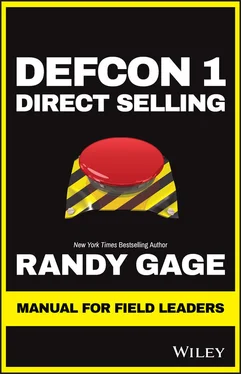In one case, a lot of their top leaders had lost confidence in the company and left en masse to join another one. In another case, the company had made major changes to the comp plan, and the results were causing a huge drop in volume and lots of resignations. In the third case, many leaders had been influenced by an outside generic trainer who had taught them systems that were actually eroding their businesses. These three leaders needed to act fast, or they would lose their teams and their livelihoods. If you develop a large team, at some point you too will face a “DEFCON 1” type of scenario for your business.
And That’s Why I’m Writing This New Book
Here’s the thing about leadership, particularly in Direct Selling. (For most of this book, I will refer to this as Leveraged Sales, which I believe is a much more appropriate label for this business model.) Most people believe leadership is about being positive all the time, sending out lots of happy, smiley emojis in their WhatsApp groups, and always giving positive motivational speeches. But the truth is, that’s not leadership—that’s propaganda. Well-meaning propaganda, surely, but propaganda nonetheless. And you’re going to have to do better than that.
That’s not to say there is no place for the “moonbeams, unicorns, and rainbows” perspective in leadership. There most certainly is. But that positive, optimistic, motivational outlook is only one element of leadership.
Because True Leadership Deals with the Messy, Complicated, and Dark Areas as Well
How do you stay true to your principles and lead the team forward when their world is falling apart because of a comp plan change, regulatory attacks, or a competitor poaching away top leaders? Or when 90 percent of the product line is on backorder, the company can’t make commissions, or there’s a sociopath in the sponsorship line above you? You’re going to need to exercise a higher level of leadership. One that reflects the yin and yang dichotomy of leading in the real world.
Here’s how I define leadership in our space:
Inspiring people to become the highest possible version of themselves—and building the environment that facilitates this process.
And to do that, you can’t just play the “only happy news” channel; you can’t just be the positive, motivational “I did it, you can do this too” channel. Your people require more from you. A lot more.
This book you are reading now is the brutal, unvarnished truth about leadership. A book like no one has ever written before. Because it is a manual for field leaders on how to handle the most challenging elements of the Leveraged Sales business. I will share with you everything I have learned over almost four decades of leading huge teams all over the world.
I’m going to reveal the entire panorama of leadership—the joyful empowering moments and the messy, discouraging ones. I’ll give you case studies and examples of my best leadership success—and lay bare my foolish, vain, and destructive mistakes as well.
A note of warning:A lot of my work is family friendly. But in my private coaching sessions and strategy sessions with my top leaders, my language is raw and uncensored (which is a nice way to say I swear a lot). Because this is meant to be a field manual for use in the most urgent and threatening emergencies and crisis situations, I’m not sugarcoating anything. So if profanity offends your sensibilities, this may not be the right book for you.
One of the Most Important Leadership Skills is the Ability to Tell the Truth
And to tell that truth with love and compassion and empathy, but truth nonetheless.
This book is a demonstration of my modeling that behavior for you. By the time your organization grows large, bad things are sometimes going to happen. Your company will make mistakes, your sponsorship line will make mistakes, other people in the profession will make mistakes, and you, yes you, will make mistakes.
There are no great leaders who don’t make mistakes. That’s only in the movies. In the real world, leadership is about recognizing, acknowledging, and owning your mistakes. And when the mistakes do happen, it’s about not trying to gloss them over, not hiding them from the team, but to concede them and explain:
How they happened, why they happened, and why they won’t happen again.
Regardless of who makes the mistakes, they will happen, and you are going to sometimes face those DEFCON 1 scenarios. It won’t matter who caused them, only how you handle those situations—drawing on your resilience, tenacity, and character to show your team you have the ability to lead them.
I wrote this book to guide you through the process of developing that resilience, tenacity, and character. And also to provide you with some background on the little-known, inside workings of our profession, the critical-thinking skills necessary to adapt to chaotic circumstances, and the wisdom to make right choices.
You’ll quickly notice I’m not starting the book with how you manage all the crisis, DEFCON 1 scenarios you are likely to face. Because the best way to handle an emergency is by preventing it from happening to begin with.
So the first chapters are about the principles you can follow, the culture you can create, and the behavior you can model that actually reduce the number of emergency situations requiring your leadership intervention. But of course, you’re still going to encounter some negative situations that are unpreventable. And the second part of this book will prepare you for resolving them in the best ways possible.
If you’re up for that, let’s get after it.
Randy Gage
—Miami Beach, Florida
February 2020
CHAPTER 1 It’s All on You
On the lovely island of Maui, with tall palm trees swaying in the breeze, I lounged poolside, working on my tan while my teammates engaged in a fierce water polo match. (And yes, literally drinking out of a coconut.) It was an incentive trip for top leaders to celebrate and reward us for another stellar year of performance. I was serenely reading a book when Jeremiah, one of the company VPs, interrupted my bliss with the news.
He relayed that he had just received a call telling him that my then-sponsor was about to jump to another company. At that very moment my sponsor—whom the company had flown to the island first class and lavished with swag, perks, excursions, and an oceanfront suite—was in that very oceanfront suite, dialing for dollars to take people to his next deal. And planning to tell me the following day.
I gazed at Jeremiah thoughtfully for a very long time. Then, sighing heavily, I said, “You know, some days I hate this goddamned job.”
I had every right to feel appalled, disappointed, and betrayed. It would have been easy for me to slip into martyr mode and seek commiseration for the injustice inflicted upon me. But here’s the reality…
The Person Most Responsible for This Turn of Events was Me
Because I had failed in my job as a leader to protect my people and create a safe environment for them. I had initially embraced this man and sponsored under him because I chose to believe that he had become the new person he assured me he was, not the person reflected by the track record he had of moving from company to company over the years.
But Here’s Where I Had Really Fallen Down
I had edified my sponsor, shared the platform with him, and facilitated his face being seen as a leader of our organization and company. By doing this, I had placed my team in a position of vulnerability. I had created a system and a culture that presented this person as a credible component of our support structure and a powerful resource for building their business.
Читать дальше












